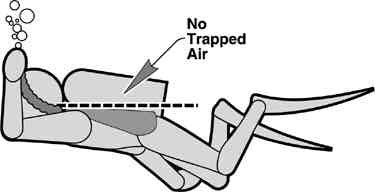Imagine if someone said to a diver, "Carry this sea anchor on every dive. You don't need it now, but there is a possibility you will need it on a dive some time a few years from now." Silly, yet this is what happens when a recreational single tank diver purchases an oversized wing primarily intended for use with doubles because they have a vision of someday becoming a technical diver. Selecting a wing oversized for their needs creates a lot of unneeded drag for which they will pay the price in extra effort and higher gas consumption on every dive, for years!
In our opinion, too much emphasis is placed on lift capacity when choosing a wing. If the diver is overweighted, they need the extra capacity to counter the excess weight, but "getting the lead out" is a separate discussion. In most diving, assuming the diver is properly weighted, the wing only needs enough lift capacity to counter the negative buoyancy of the complete cylinder configuration carried by the diver as they enter the water.
One often hears justification for needing excess lift is because the diver carries a very large amount of lead weight to counter the buoyancy of their thick wetsuit or drysuit and needs the excess lift capacity "just in case." The solution is not to have an oversized wing to counter the weight, but rather, to configure the lead so it can be incrementally dropped in an emergency. Yes, we acknowledge there are special circumstances in extreme technical diving that require enormous excess lift capacity, but these are pretty rare. In general, lift capacity when choosing a wing is a minor consideration.
Beyond the issue of drag, there is a special buoyancy control concern when using an oversized back-inflation style BC wing inappropriate for the size of the tank or tanks. The figure below illustrates an oversized aircell. Air inside the cell causes the wing to wrap around the tank in a manner similar to a taco. This 'taco' effect traps air above the level of the BC hose elbow when the diver is in a normal swimming position, which may interfere with venting (deflating) the BC.

The figure below shows the benefit of eliminating tank wrap by correctly sizing the aircell with the tank or tanks. The entire wing is now below the level of the BC hose elbow, allowing the diver to vent (deflate) the aircell either by using the remote exhaust valve in the hose elbow or by holding the end of the hose up and depressing the oral inflation/manual deflation button.

Some circumstances create a need for "backup" lift capacity ("backup" does not mean "more"). When diving larger steel doubles configurations, the typical diver has such negative buoyancy when entering the water that it would be difficult, perhaps impossible, to swim to the surface in event of a buoyancy control failure. Some divers feel a drysuit will serve for backup buoyancy control, especially if the diver is able to remain horizontal at all times. Many disagree and the diver should perform a controlled trial to prove they may rely upon their drysuit as a backup BC. When diving with very negative configurations and a wetsuit or unproven drysuit, the need for a backup buoyancy becomes critical and this is the justification for redundant bladder wings.
Our Recommendation: The cylinder size, type and configuration is the best guide to selecting the correct wing. While many doubles wing designs can be compressed to a more compact size for occasional use with singles, keep in mind they are not designed to be used primarily as singles wings and when compressed they are not optimal. Realistically, there is no wing perfect for both singles and doubles, or even a wing perfect for all doubles. That's why there is a range of wing sizes, each one best suited to a specific range of cylinder configurations. Wing selection is not difficult if you first determine which cylinder configuration you will most likely be diving and only then choose the wing best suited to that configuration. For obvious budget reasons a diver would like to own only one wing, suitable for "all occasions." But if the range of cylinder configurations you dive is broad, then the best choice for efficient, safe and comfortable diving may be to own more than one wing.